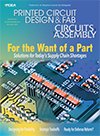Features Articles

Stronger, faster and more robust networks will be one of the positive legacies of the pandemic.
Hopefully, we will soon be able to start living our post-Covid-19 lives. Going forward, some of us want fundamental changes. Others are keen to return to the way things were. Although we will be pleased to put this situation behind us, some things are here to stay. One, obviously, is the lethal group of coronaviruses that will surely continue to take lives after lockdown (we hope at a greatly reduced rate). Another, I believe, is the tendency for many of us to continue working from home (WFH) to a much greater extent than before.
WFH has been one of the headline trends of this crisis. Although clearly not to everyone’s taste, it could turn into a revolution founded on the internet technologies that allow us to meet with colleagues online, access data and tools remotely, and benefit from high connection speeds wherever we are – wired or wireless. That so many can do meaningful work this way also reflects the soft nature of many tasks associated with getting things done in developed economies. These soft deliverables liberate us from location and will be critical to our economic survival of this pandemic.
Many are keen to recover the social dimension to our working lives. While physically working together in the same space and time to achieve shared goals is a powerful part of team building and cohesion, we can also take advantage of the flexibility to ease some of the more stressful aspects, such as traveling and being away from loved ones.
To continue reading, please log in or register using the link in the upper right corner of the page.

It’s a drink from an educational firehose, but the lessons will pay off.
Many will disagree with this column’s title this month, especially supply-chain professionals working 24/7 to address a market with varying material constraints, continual logistics challenges and unforecasted demand spikes. That said, over the past few years the electronics manufacturing (EMS) industry has had a changing of the guard. While some replacements are veterans of the last round of market constraints, most haven’t seen the perfect storm that 2021 represents. The lessons learned this year will create invaluable experience for this next generation of leadership. Here are a few examples:
Information technology. Over the past decade, even small EMS companies have upgraded their IT capabilities to provide real-time visibility into most of their critical metrics. However, while an exception-based real-time system is wonderful in situations where exceptions happen in relatively low volumes, it creates information overload when it is identifying hundreds of exceptions in a month. The current market challenges are driving management teams to analyze what data they need to prioritize and how that data can be best formatted to help them stay ahead of shortages or capacity constraints. This will broaden the use of time-saving apps and create management teams with a better understanding of systems strategy strengths and weaknesses.
To continue reading, please log in or register using the link in the upper right corner of the page.

Communications interfaces rely on handshakes, but software and simplicity no longer go hand-in-hand.
“Plug-and-play” seems a simple, efficient concept, a beautiful merger of elegant design and high technology. What happened to it?
I forget exactly when I first heard the term plug-and-play, but it was sometime back in the late 1980s. As I recall, consumer electronics had something to do with it – perhaps a VCR player that connected to a TV. Or possibly it was tied to early personal computers, where the various accessories could be mixed and matched, so any brand of monitor, printer or keyboard could be added interchangeably to the system. Wherever the phrase came from, the meaning was universal: You could replace one part of a system with a new or different component, and the system would operate without a hitch.
In business the term seemed to morph in two directions. In administrative office environments, the term was associated with updates or upgrades to software. Transitioning spreadsheet software such as Lotus 1-2-3 to, say, Quattro Pro was seamless, thanks to the elegant design of similar operating commands. Just upload the new software onto your computer and begin using it. Meanwhile, on the manufacturing floor, a new piece of capital equipment could be dropped into the process flow and hooked up, and it fit seamlessly with the existing machines. Voila! New replaced old. Simple, easy, painless.
To continue reading, please log in or register using the link in the upper right corner of the page.

Munitions are cool again.
Well, maybe they always were. But the emphasis by North American manufacturers on procuring defense contracts has perhaps never been greater.
In the throes of the dotcom meltdown of late 2001 to early 2003, when China and Taiwan hoovered up the vast majority of the Western PCB market, forcing those hardy remaining souls to repurpose their business plans, the Pentagon became an unwitting savior. Manufacturer after manufacturer pivoted from the “3Cs” (computers, communications, consumer) to CET&I (military communications, electronics, telecommunications, and intelligence technologies). They eschewed past complaints of onerous red tape and sprung for the certifications to elbow their way into the Pentagon supply chain.
There wasn’t much choice at the time. It was military or bust.
Going back to 2001, the United States made about 45% of the world’s electronics equipment. Defense and related high-rel sales made up less than 10% of the US domestic fabrication market, which at the time was coming off a record year at around $11 billion in production output spread across 650 or so facilities.
We all know what happened.
To continue reading, please log in or register using the link in the upper right corner of the page.

Quality is found in the design as well as the process.
Solder defects are inevitable. Reducing their risk is mandatory, especially if you’re aiming to make money as a result of operations. Machines are certainly not “almost human,” but they do go through seasonal changes and have moods. Without proper upkeep, they fall into disrepair. The goal in assembly is to dial in the thermal profile of the soldering equipment to minimize solder defects.
Footprint model accuracy is an enabler, but that work can be undone by improper routing and copper-flooding techniques. Placement too near the edge of the board where the temperature fluctuates to a greater degree can decrease yields through the soldering process. Tombstoning is one thing to watch for, but other dangers are present on the frontier.
The Goldilocks zone. Another defect can occur when one lead of a component is close to the edge while the other is farther inward. Wirewound resistors and inductors can become open circuits or more insidiously latent defects, where the wire pulls away from the lead only when there is a temperature rise or a mechanical shock to the system. Ceramic caps can actually crack when one lead solidifies before the other one.
To continue reading, please log in or register using the link in the upper right corner of the page.

As-supplied component residues are often the culprit.
This month we look at dewetting on the surface of solder mask or components in manufacture.
FIGURES 1 and 2 show the impact of dewetting on the surface of plastic components in conformal coating. Figure 2 illustrates dewetting on solder mask. In both cases if the coating does not cover all the critical areas of the assembly, it must be reworked. It is up to the quality and design departments to agree what level, if any, of dewetting is acceptable to the product and the customer, rather than just quoting a standard. In some cases, the position or level of the problem may not affect the product operation or reliability.
To continue reading, please log in or register using the link in the upper right corner of the page.


